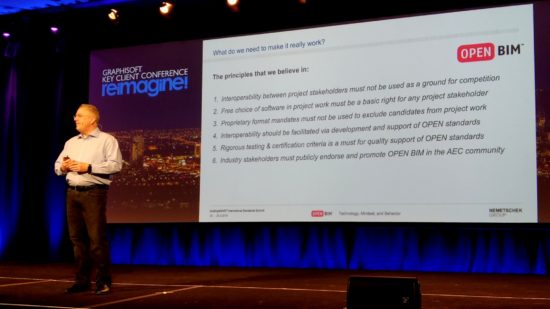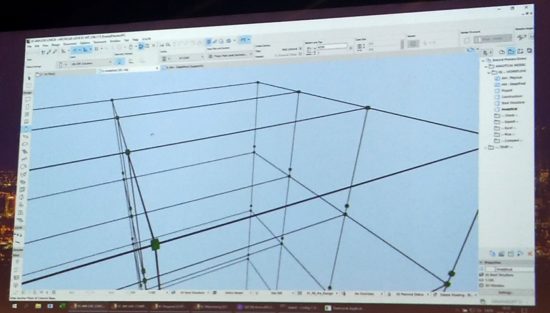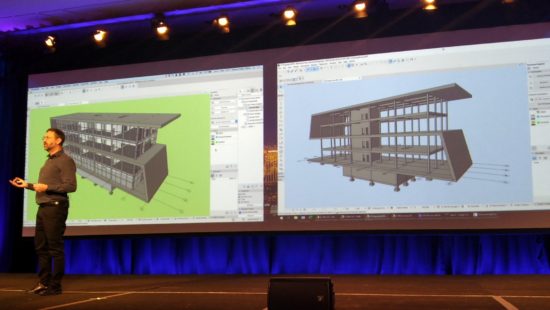Leveraging its internal strengths and the breadth of parent company Nemetschek.
Graphisoft is the Hungarian software company that began in 1984 when Gábor Bojár thought of designing buildings virtually in 3D. As a result, ArchiCAD became the earliest version of BIM (building information modeling) software. In fact, it was so 3D oriented that generating 2D plans was an afterthought. This year, Graphisoft will release ArchiCAD 23.
Graphisoft is still headquartered in Budapest, but now is part of the 16 “brands” acquired by the Nemetschek Group holding company of Germany. Graphisoft’s other programs include BIM Server (for collaboration), MEP Modeler (ductwork and piping), EcoDesigner (energy efficiency), and BIMx for viewing models on mobile devices and computers.
Nemetschek is now the second largest AEC software vendor, after Autodesk, and ArchiCAD is mostly second to Revit, albeit #1 in some markets. Graphisoft this year appointed a new CEO, Huw Roberts, an American architect who previously worked at Bentley Systems and BlueCielo.

Mr. Roberts wants to make ArchiCAD #1 in all markets. He sees strengths in Graphisoft and weaknesses in Autodesk that he can exploit.
The primary attack vector is ArchiCAD versus Revit. The ancillary weapons are the many additional programs that Nemetschek owns, such as steel analysis (Risa), collision detection (Solibri), rendering (Maxon), and PDF-based collaboration (Bluebeam), some of which are best-in-class.
At the annual Graphisoft Key Customer Conference (KCC) in June, Mr. Roberts and other Graphisoft executives described, in a fair amount of detail, their plans for the future of the ArchiCAD software and the Graphisoft company. Two points jumped out at me to indicate how Graphisoft plans to target Autodesk.
Mr. Roberts wants to make ArchiCAD #1 in all markets. He sees strengths in Graphisoft and weaknesses in Autodesk that he can exploit.
The primary attack vector is ArchiCAD versus Revit. The ancillary weapons are the many additional programs that Nemetschek owns, such as steel analysis (Risa), collision detection (Solibri), rendering (Maxon), and PDF-based collaboration (Bluebeam), some of which are best-in-class.
At the annual Graphisoft Key Customer Conference (KCC) in June, Mr. Roberts and other Graphisoft executives described in a fair amount of detail their plans for the future of the ArchiCAD software and the Graphisoft company. Two points jumped out at me to indicate how Graphisoft plans to target Autodesk.
Prong 1. Treat customers better. Mr. Roberts is firm on giving customers what they want, and so not imposing his will on them. The company has been building out a distributor network by quietly buying up regional dealers worldwide. Local dealers understand the markets better than head office.
Autodesk is infamous for imposing subscriptions and massive collections of software on its customers. By constant, Graphisoft offers permanent licenses and subscription options, while Nemetschek handles on an a-la-carte basis all the other software that a design firm might need.
But treating potential customers nicely won’t be enough to wrench them away from Revit. As a dealer from Vietnam told me, students choose to learn Revit over ArchiCAD simply because that’s where most jobs are. Graphisoft needs something so compelling that a Revit shop would be willing to endure the pain of a switch-over. The compelling offer Nemetschek–Graphisoft came up with is to connect disciplines effortlessly.
Prong 2. Interconnected software. BIM was supposed to be an all-in-one solution for designing buildings, yet it has proven unsuitable for crucial tasks like building analyses, generating cut lists for manufacturing, or even letting the owner effortlessly see what’s going on. BIM has silos, and silos separate data from the architect from the engineer, from the builder, and from the owner.
One key goal of Nemetschek Group (and a few other CAD vendors) is to support OpenBIM and IFC files. This is unsurprising, given that the dozen programs Nemetschek acquired were from disparate sources and so they needed a common way by which to communicate. But, Mr. Roberts said, if it takes 40 minutes to open an IFC file (which I have seen in other software), then a program doesn’t really support OpenBIM.
Autodesk, by contrast, is infamous for the hard time it has in making its 175 programs compatible with one another. At the current time, Navisworks is Autodesk’s best solution to viewing models from multiple incompatible sources, while the cloud-based AnyCAD handles translation duty between programs, although primarily MCAD ones.
Project Everest is Graphisoft’s name to reach the #1 BIM position by eliminating silos. The point to Everest is to make data interchange effortless, and at this year’s conference, we saw a half-dozen examples of how it would work.
In the clearest example, an architect did some initial structural analysis. ArchiCAD showed green dots at good connections between steel members, and red ones at problem ones, such as where the cladding hid connections from the architect’s view.

Then the architect sent the 3D model to an engineer. But instead of showing the entire 3D model in its semi-rendered glory, ArchiCAD was smart enough to send just the steel structure (beams, columns, connections). The engineer did the analysis; if there were strength problems, the changes were sent back.
Here was the wow moment: the architect used the 3D compare function to see the before and after versions, and then had ArchiCAD automatically stretch beams and columns to match the engineer’s recommendation.
We also saw a customizable commenting system: the engineer, for instance, could specify that he does not see any comments that did not relate to his field, such as interminable discussions over paint color.

More linkages are to come between ArchiCAD and many of Nemetschek’s brands, along with some from third-party programmers. External programs tie into Everest with two new APIs (application programming interfaces), one based on Python, the other on JSON. Third-party developers writing for other CAD systems may be able to port their add-on from, say, Revit.
While Graphisoft feels Everest is meant primarily for large architectural firms that have all these resources in-house running on internal servers, I can see the advantage for the one-man firm sending steel analysis to an outside contractor—I’m just not sure how the data linkage would work.
Conclusion
Everest is not just a project to make data exchange effortless; we already are pretty good at translation these days. It goes the next step to exchanging only the data a discipline needs and doing so in an instant. The same for commenting systems.
This is the leg-up Graphisoft is hoping to gain over Autodesk, a company that for nearly a decade has promised an all-in-format but has so far failed to deliver. Graphisoft is also promising, but at least it has an interdisciplinary design system (that adapts itself to each discipline) it can show existing and potential cross-grade customers.
This feels to me like a PDF moment, when John Warnock found a way to make written communications universal, and trivially simple—with a lot of hard work in the background. Should Everest work as planned, then we will have arrived at a new era when interdisciplinary work on huge design projects also becomes universal and trivially simple—with a lot of hard work in the background.
Graphisoft could not tell us when Everest will be available, just that it won’t be in ArchiCAD 23, which is shipping this September.





